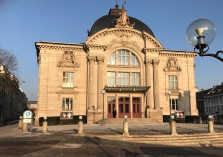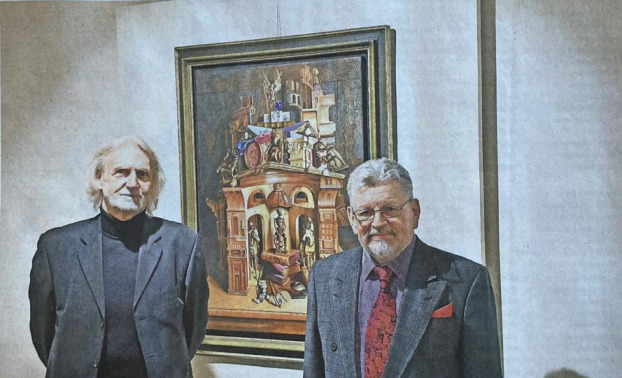room for humour
Vernissage: 16.03.2025
Artist Profile
Michael Lassel
Invitation Archive
Artworks
Michael Lassel
Price List
Michael Lassel
|
Nr. |
Titel |
Technik |
Maße |
Preise |
|
|
Foyer |
|
|
|
|
101 |
Zeugnisse der Wahrheit |
Öl auf Leinwand |
90x110 |
56.000 |
|
102 |
Die große Kuppel |
Öl auf Leinwand |
60x73 |
35.000 |
|
103 |
Schöner Brunnen |
Öl auf Leinwand |
73x84 |
63.000 |
|
104 |
Galerie der Ganoven |
Öl auf Leinwand |
65x55 |
22.400 |
|
105 |
Melancolia |
Öl auf Leinwand |
60x70 |
36.400 |
|
106 |
Seifenoper |
Öl auf Leinwand |
90x60 |
25.200 |
|
107 |
Titania |
Öl auf Leinwand |
100x80 |
58.800 |
|
108 |
Fine Art Fair |
Öl auf Leinwand |
50x60 |
15.400 |
|
109 |
Der Schrein |
Öl auf Leinwand |
70x60 |
42.000 |
|
110 |
Königsplatz |
Öl auf Leinwand |
85x65 |
35.000 |
|
111 |
Exodus |
Öl auf Leinwand |
70x60 |
36.400 |
|
112 |
Ein ewig' Rätsel |
Öl auf Leinwand |
70x60 |
30.800 |
|
113 |
Blick vom Kapitell |
Öl auf Leinwand |
60x50 |
35.000 |
|
114 |
Edikt |
Öl auf Leinwand |
50x60 |
35.000 |
|
115 |
La larme rouge |
Öl auf Leinwand |
60x50 |
35.000 |
|
116 |
Der Baum |
Öl auf Leinwand |
60x50 |
30.800 |
|
117 |
Mitgift der Prinzessin |
Öl auf Leinwand |
60x50 |
30.800 |
|
118 |
Verlassenes Nest |
Öl auf Leinwand |
70x60 |
36.400 |
|
119 |
Horse Guards |
Öl auf Leinwand |
95x65 |
54.600 |
|
120 |
Reflexion der Zeit |
Öl auf Leinwand |
70x60 |
44.800 |
|
121 |
Tagebuch |
Öl auf Leinwand |
76x86 |
36.400 |
|
|
2. Rang rechts |
|
|
|
|
122 |
Die segnende Hand |
Öl auf Leinwand |
120x100 |
35.000 |
|
123 |
Testament |
Öl auf Leinwand |
85x75 |
35.700 |
|
|
2. Rang links |
|
|
|
|
124 |
Vermählung der Gliederpuppen |
Öl auf Leinwand |
65x55 |
33.600 |
|
125 |
Beletage |
Öl auf Holzplatte |
46x56 |
30.800 |
|
126 |
Aedicula |
Öl auf Leinwand |
81x56 |
56.000 |
Irrtum vorbehalten. Preise inklusive Rahmen.
Press Archive
Fürther Nachrichten, March 19, 2025, MICHAELA HÖBER
Trickster, Deceiver, Humorist
Michael Lassel has achieved international success with his timeless Trompe-l’oeil technique.
"I want to present the world in a more accentuated way": Michael Lassel (right) with gallerist John Hammond in the foyer of the municipal theater. Photo: Thomas Scherer
FÜRTH – “World Theatre” is the title of the new exhibition that John Hammond’s Art Agency has been presenting at the municipal theater for a few days now. It leads directly into the dazzling stylistic worlds of Fantastic Realism and Magical Illusionism. Michael Lassel, an internationally renowned representative of Trompe-l’œil painting for many years, is showcasing 26 oil paintings from his extensive body of work spanning from 1991 to 2024.
But what does Trompe-l’œil actually mean? The French term translates to something like “deceptive appearance” or “optical illusion” and refers to a style of painting that, through precise perspective rendering, creates such a sense of depth that it appears almost three-dimensional — an art form with a long history. Many Baroque churches are filled with Trompe-l’œil effects. “I don’t just deceive the eye; I deceive the senses as well. I want to portray the world in a more accentuated way,” says Michael Lassel about his painting, which is, among other things, inspired by 17th-century Dutch art.
In his three-dimensionally constructed pictorial spaces, the artist combines elements of still life with symbolically heightened, enigmatic objects. Familiar items from everyday life are placed in surreal juxtapositions. The combination of depicted objects — such as busts, instruments, tools, playing cards, coins, or curious flea market finds — triggers a wide range of associations. “You can only interpret what you already know,” says Lassel. And indeed, there is much to discover in terms of hidden clues, quotations, and symbols, once you immerse yourself in his, in the best sense, old-fashioned visual worlds.
One painting, for example, titled “Schöner Brunnen” (“Beautiful Fountain”) from 1995, is whimsically and playfully constructed from beer steins and gingerbread tins — items typically associated with Nuremberg. At the top sits the iconic “Nürnberger Trichter” (a traditional symbol of learning), and in the background, etchings of the Schöner Brunnen can be vaguely seen. What’s not immediately visible is pointed out by cultural manager Georg von Matuschka in his introduction: “On one of the gingerbread tins, Michael Lassel has portrayed himself alongside three French Trompe-l’œil artists, thereby creating a link between the Franconian metropolis of Nuremberg and France. And for the expiration date, he humorously used his own date of birth.”
In Lassel’s painting “Abandoned Nest” from 2021, one finds — alongside an antique belt, old musical instruments, and the artist’s pipe collection — a hidden reference to the “Chocolate Girl” by the Geneva artist Jean-Étienne Liotard, from the Old Masters Gallery in Dresden. “Mixing such quotations together creates a new story,” says the painter, who assigns each object in the image its own specific value. “Melancolia”, completed last year, is the final work Lassel finished for the current exhibition. It speaks of farewell and transience: in the center is a bust of a girl, a tear rolls from her closed eye, and the grandiose fantasy architecture above her is cracked open, telling of faded splendor.
Michael Lassel, born in 1948 as a Transylvanian Saxon in Romania, has lived in Fürth since 1986. He has participated in exhibitions worldwide — from Geneva, Paris, and London to Singapore, Tokyo, and New York. One of his works is a 1998 portrait of former mayor Uwe Lichtenberg, which hangs in Fürth’s city hall and is part of the Gallery of City Leaders. Lichtenberg served as mayor from 1984 to 1996.
Interpretation of Michael Lassel's painting called
THE TREE (DER BAUM) from 2014,
by Georg von Matuschka in 2025.
Many of Michael Lassel's paintings can be read like a book. The objects depicted, with all their historical and cultural references, offer the curious viewer a welcome challenge to follow the traces laid down and explore these global connections, unraveling them piece by piece.
In the painting entitled "The Tree" from 2014, I was interested in the arrangement of banknotes in front of a symbol of a supposed trademark, "Europe as a Circle of Stars." First, it is important to clarify and clarify the specific types of banknotes in question.
When British pound notes are seen next to Romanian and Hungarian banknotes, initial references to Michael Lassel's biographical background, his origins in Transylvania (Romania), his cultural and political connection to Hungary, and his travels to England and France can already be drawn.
Surprisingly, in all the texts I have found on the masterful trompe l'oeil paintings, I have not found a detailed interpretation of a single work from his oeuvre. This perceived lack of interpretative approach is regrettable and requires a thorough examination of the artist's work, who presents over 120 trompe l'oeil paintings from his creative period between 1989 and 2024 in the "WORKS" menu on his website.
According to him, he has painted around 150 paintings in this style to date, March 2025.
At first glance, we see a multitude of differently colored banknotes above a pile of coins, all of which, we initially assume, originate from European countries or states. In Lassel's work, we repeatedly encounter depictions of coins and banknotes. The references these real objects make to concepts such as prosperity, power, wealth, nations, rulers, and the numerical values of these means of exchange are only one side of the coin.
With his sophisticated arrangements, Lassel conveys references to the depicted numbers, portraits, and graphic elements of the coins and banknotes, always also to historical events, politicians, rulers, scientists, architecture, artists, musicians, poets, and thinkers who have been "immortalized" on the banknotes and coins, even when they no longer meet current trade and commodity exchange requirements and have become practically "worthless." LASSEL uses these "portrait graphics" and "painted reliefs" as eye-catchers, allowing the story of the depicted scenes to be imagined beyond the frame through thought and association games.
Viewing is a new way of seeing, gaining knowledge through masterful representation. (See works "Bankier und guter Gesellschaft" 2019, "Das Vermögen" 2016) The stacked banknotes shown in the painting "The Tree" are arranged in this work so that they take on the shape and surface of a triangle or pyramid. In reference to the title, this could be seen as a tree formation: the broad base at the bottom and the tapering upwards, a point reaching into the treetop.
A toy-like winged horse figure, a "Pegasus" symbol, sits enthroned at the top. The word "treetop" also has a certain connotation when one identifies the portrait of the British Queen Elizabeth II, wearing a diadem, on a 5-pound note as Queen of England (£5), in the central midfield. The entire banknote arrangement is arranged against the backdrop of a panel wall consisting of several wooden boards.
This wall, in turn, displays several striking characteristic features. Eleven five-pointed stars of equal size are emblazoned in a wooden circular ring relief. The blue paint, which probably once covered the entire wooden surface with a uniform royal blue varnish, has either weathered, flaked off, or disappeared completely.
The end grain of the boards is fascinatingly presented in relief with its linear patterns. This, too, alludes to its growth and biological origin. Dead wood as a building material and wall that blocks the view into a spatial background. This circular star formation on tree material creates thought experiments on nature and timber, forest and land, life and deadwood. Tree of life, family tree, ancestry, and ramifications. The fact that the paper banknotes are mostly made of cotton and contain cellulose and color printing is the material core and real reference.



































































































